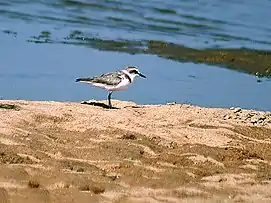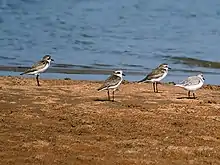Plover
Plovers (/ˈplʌvər/ or /ˈploʊvər/) are a widely distributed group of wading birds belonging to the subfamily Charadriinae.
| Plovers | |
|---|---|
 | |
| Hooded dotterel (Thinornis rubricollis) | |
| Scientific classification | |
| Kingdom: | Animalia |
| Phylum: | Chordata |
| Class: | Aves |
| Order: | Charadriiformes |
| Family: | Charadriidae |
| Subfamily: | Charadriinae Leach, 1820 |
| Genera | |
|
Pluvialis | |
_W_IMG_0104.jpg.webp)



Description
There are about 66 species in the subfamily, most of them called "plover" or "dotterel".[1] The closely related lapwing subfamily, Vanellinae, comprises about 20 species.[2]
Plovers are found throughout the world, with the exception of the Sahara and the polar regions, and are characterised by relatively short bills. They hunt by sight, rather than by feel as longer-billed waders like snipes do. They feed mainly on insects, worms or other invertebrates, depending on the habitat, which are obtained by a run-and-pause technique, rather than the steady probing of some other wader groups.[3] Plovers engage in false brooding, a type of distraction display. Examples include pretending to change position or to sit on an imaginary nest site.
Species list in taxonomic order
The International Ornithological Congress (IOC) recognizes these 45 species of plovers and dotterels. They are distributed among 10 genera, some of which have only one species. One species on the list, the Javan lapwing, is extinct.[4]
This list is presented according to the IOC taxonomic sequence and can also be sorted alphabetically by common name and binomial.
| Common name | Binomial name | IOC sequence |
|---|---|---|
| Red-kneed dotterel | Erythrogonys cinctus | 1 |
| Inland dotterel | Peltohyas australis | 2 |
| Wrybill | Anarhynchus frontalis | 3 |
| European golden plover | Pluvialis apricaria | 4 |
| Pacific golden plover | Pluvialis fulva | 5 |
| American golden plover | Pluvialis dominica | 6 |
| Grey plover | Pluvialis squatarola | 7 |
| New Zealand plover | Charadrius obscurus | 8 |
| Common ringed plover | Charadrius hiaticula | 9 |
| Semipalmated plover | Charadrius semipalmatus | 10 |
| Long-billed plover | Charadrius placidus | 11 |
| Little ringed plover | Charadrius dubius | 12 |
| Wilson's plover | Charadrius wilsonia | 13 |
| Killdeer | Charadrius vociferus | 14 |
| Piping plover | Charadrius melodus | 15 |
| Madagascan plover | Charadrius thoracicus | 16 |
| Kittlitz's plover | Charadrius pecuarius | 17 |
| St. Helena plover | Charadrius sanctaehelenae | 18 |
| Three-banded plover | Charadrius tricollaris | 19 |
| Forbes's plover | Charadrius forbesi | 20 |
| White-fronted plover | Charadrius marginatus | 21 |
| Kentish plover | Charadrius alexandrinus | 22 |
| White-faced plover | Charadrius dealbatus | 23 |
| Snowy plover | Charadrius nivosus | 24 |
| Javan plover | Charadrius javanicus | 25 |
| Red-capped plover | Charadrius ruficapillus | 26 |
| Malaysian plover | Charadrius peronii | 27 |
| Chestnut-banded plover | Charadrius pallidus | 28 |
| Collared plover | Charadrius collaris | 29 |
| Puna plover | Charadrius alticola | 30 |
| Two-banded plover | Charadrius falklandicus | 31 |
| Double-banded plover | Charadrius bicinctus | 32 |
| Lesser sand plover | Charadrius mongolus | 33 |
| Greater sand plover | Charadrius leschenaultii | 34 |
| Caspian plover | Charadrius asiaticus | 35 |
| Oriental plover | Charadrius veredus | 36 |
| Eurasian dotterel | Charadrius morinellus | 37 |
| Rufous-chested plover | Charadrius modestus | 38 |
| Mountain plover | Charadrius montanus | 39 |
| Hooded dotterel | Thinornis cucullatus | 40 |
| Shore dotterel | Thinornis novaeseelandiae | 41 |
| Black-fronted dotterel | Elseyornis melanops | 42 |
| Tawny-throated dotterel | Oreopholus ruficollis | 43 |
| Diademed sandpiper-plover | Phegornis mitchellii | 44 |
| Pied plover | Hoploxypterus cayanus | 45 |
In folklore
The European golden plover[5] spends summers in Iceland, and in Icelandic folklore, the appearance of the first plover in the country means that spring has arrived. The Icelandic media always covers the first plover sighting, which in 2017 took place on March 27, 2017.[6]
References
- Coomber, Richard (1991). "Charadriiformes: Plovers". Birds of the World. Godalming, Surrey: Colour Library Books. pp. 97–100. ISBN 978-0862838065.
- Sangster, G.; Knox, A. G.; Helbig, A. J.; Parkin, D. T. (2002). "Taxonomic recommendations for European birds". Ibis. 144 (1): 153–159. doi:10.1046/j.0019-1019.2001.00026.x.
- Perrins, Christopher (2003). The New Encyclopedia of Birds. Oxford U. P. ISBN 978-0-19-852506-6.
- Gill, F.; Donsker, D.; Rasmussen, P. (January 2021). "IOC World Bird List (v 11.1)". Retrieved January 14, 2021.
- "The Golden Plover has arrived, indicating spring in Iceland". IceNews - Daily News. March 27, 2017. Retrieved 4 April 2018.
- "Spring has arrived in Iceland, according to folklore". mbl.is. Retrieved 4 April 2018.
External links
| Wikispecies has information related to Charadriinae. |
- Plover videos, photographs & sounds on the Internet Bird Collection.